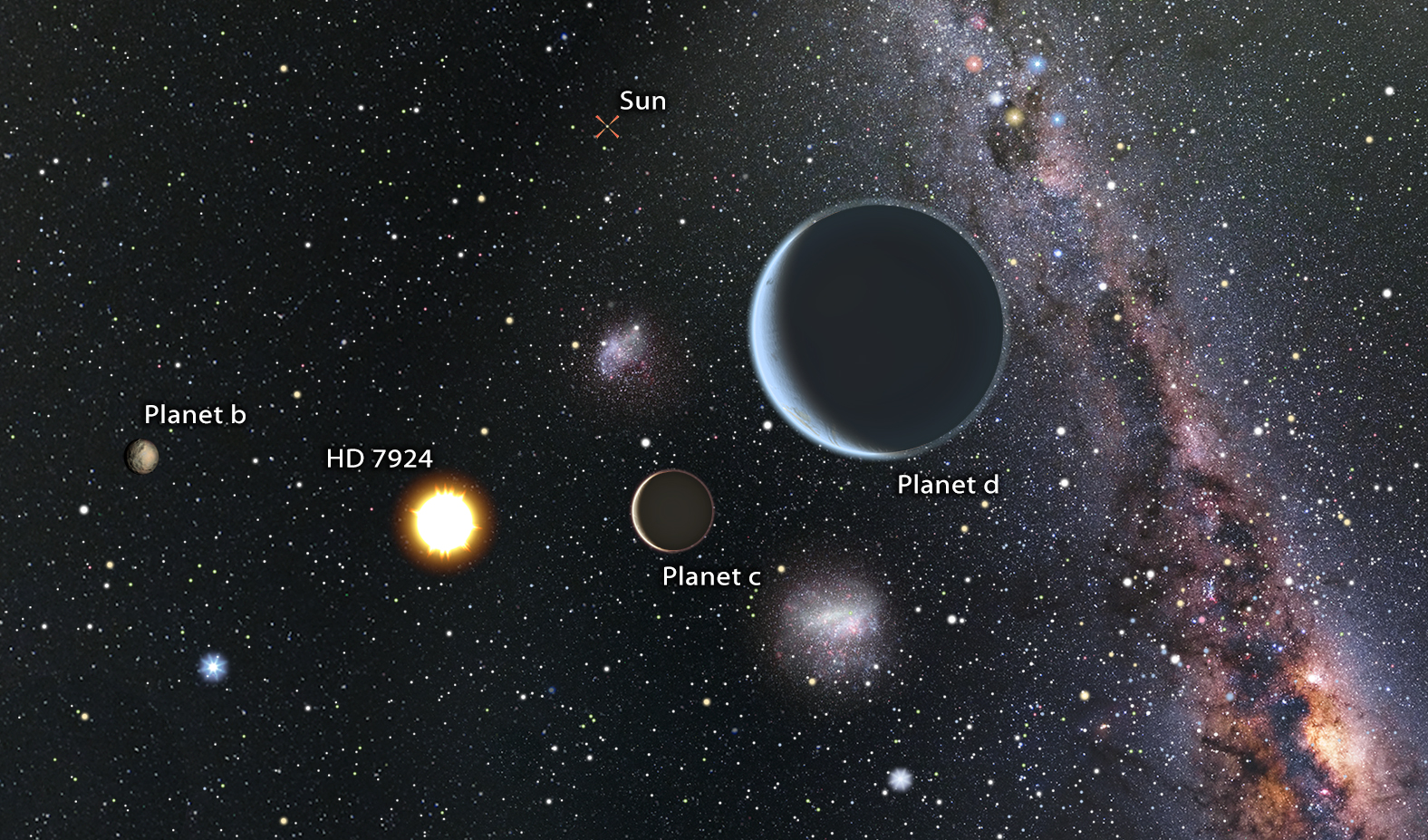University of California Observatories
Astronomers Discover Three
Super-Earths Orbiting Nearby Star
April 28, 2015
Astronomers have discovered a planetary system orbiting a star only 54 light-years away with the Automated Planet Finder (APF) at Lick Observatory and ground-based telescopes in Hawaii and Arizona.
The team discovered the planets by detecting a wobble of the star HD 7924, a result of the gravitational pull of the planets orbiting around it. All three planets orbit the star at a distance closer than Mercury orbits the sun, completing their orbits in just 5, 15, and 24 days.
The APF facility at Lick Observatory offers a way for astronomers to speed up the exoplanet search. The fully-robotic telescope searches for planets every clear night of the year, so planets and their orbits can be discovered and traced quickly.
“The APF is great for two reasons. One, it has the superb Levy spectrometer. Two, it is a modern computer controlled telescope so we can automate it. This combination means that we can observe stars night in and night out to look for the wobble,” said Bradford Holden, an Associate Research Astronomer for UC Observatories (UCO) who helped to make the telescope robotic.
"The automation of the telescope means that astronomers can fully use all the time available, and make discoveries faster," he said.
Training computers to run the observatory all night, without human oversight, took years of effort by the UCO staff and graduate students on the discovery team.
“We initially used APF like a regular telescope, staying up all night searching star to star. But the idea of letting a computer take the graveyard shift was more appealing after months of little sleep. So we wrote software to replace ourselves with a robot,” said University of Hawaii graduate student Benjamin “BJ” Fulton.
The Keck Observatory found the first evidence of planets orbiting HD 7924, discovering the innermost planet in 2009 using the HIRES instrument installed on the 10-meter Keck I telescope. This same combination was also used to find other super-Earths orbiting nearby stars in planet searches led by UH astronomer Andrew Howard and UC Berkeley Professor Geoffrey Marcy. It took five years of additional observations at Keck Observatory and the year-and-a-half campaign by the APF Telescope to find the two additional planets orbiting HD 7924. The Automatic Photometric Telescope (APT) at Fairborn Observatory in Arizona also made crucial measurements of the brightness of HD 7924 to assure the validity of the planet discoveries.
The Kepler Space Telescope has discovered thousands of extrasolar planets and demonstrated that they are common in our Milky Way galaxy. However, nearly all of these planets are far from our solar system. Most nearby stars have not been thoroughly searched for the small “super-Earth” planets (larger than Earth but smaller than Neptune) that Kepler found in great abundance.
This discovery shows the type of planetary system that astronomers expect to find around many nearby stars in the coming years. “The three planets are unlike anything in our solar system, with masses 7-8 times the mass of Earth and orbits that take them very close to their host star,” explains UC Berkeley graduate student Lauren Weiss.
Observations by APF, APT, and Keck Observatory helped verify the planets and rule out other explanations. “Starspots, like sunspots on the sun, can momentarily mimic the signatures of small planets. Repeated observations over many years allowed us to separate the starspot signals from the signatures of these new planets,” explains Evan Sinukoff, a UH graduate student who contributed to the discovery.
The robotic observations of HD 7924 are the start of a systematic survey for super-Earth planets orbiting nearby stars. Fulton will lead this two-year search with the APF as part of his research for his doctoral dissertation. “When the survey is complete we will have a census of small planets orbiting sun-like stars within approximately 100 light-years of Earth,” says Fulton.
The paper presenting this work will be published in the Astrophysical Journal on April 29, and is available online here. The authors of the paper are Benjamin J. Fulton (UH), Lauren M. Weiss (UC Berkeley), Evan Sinukoff (UH), Howard Isaacson (UC Berkeley), Andrew W. Howard (UH), Geoffrey W. Marcy (UC Berkeley), Gregory W. Henry (TSU), Bradford P. Holden (UCO), and Robert I. Kibrick (UCO.)
In honor of the donations of Gloria and Ken Levy that helped facilitate the construction of the Levy spectrograph on APF and support Lauren Weiss, the team has informally named the HD 7924 system the “Levy Planetary System.” The team also acknowledges the support of NASA, the U.S. Naval Observatory, and the University of California for its support of Lick Observatory.
Lick Observatory is located on the summit of Mt. Hamilton in the Diablo Range east of San Jose. Founded in 1888, Lick Observatory is at the forefront of astronomical research as an active research facility. It is operated by the UC Observatories (UCO), a multi-campus research unit that serves eight UC campuses and is headquartered at UC Santa Cruz.

Artist’s impression of a view from the HD 7924 planetary system looking back toward our sun, which would be easily visible to the naked eye. Since HD 7924 is in our northern sky, an observer looking back at the sun would see objects like the Southern Cross and the Magellanic Clouds close to our sun in their sky. Art by Karen Teramura & BJ Fulton, UH IfA.
Media Contacts:
Hilary Lebow
(831) 459-3455
lebow@ucolick.org
APF Contact: Bradford Holden
(831) 459-3387
holden@ucolick.org
Science Contact: BJ Fulton
(408) 528-4858
bfulton@hawaii.edu
Coverage:
UH Press Release
UC Berkeley
SF Gate
CBS SF
NPR
Astronomy Magazine
International Business Times
Tech Times
The Washington Post